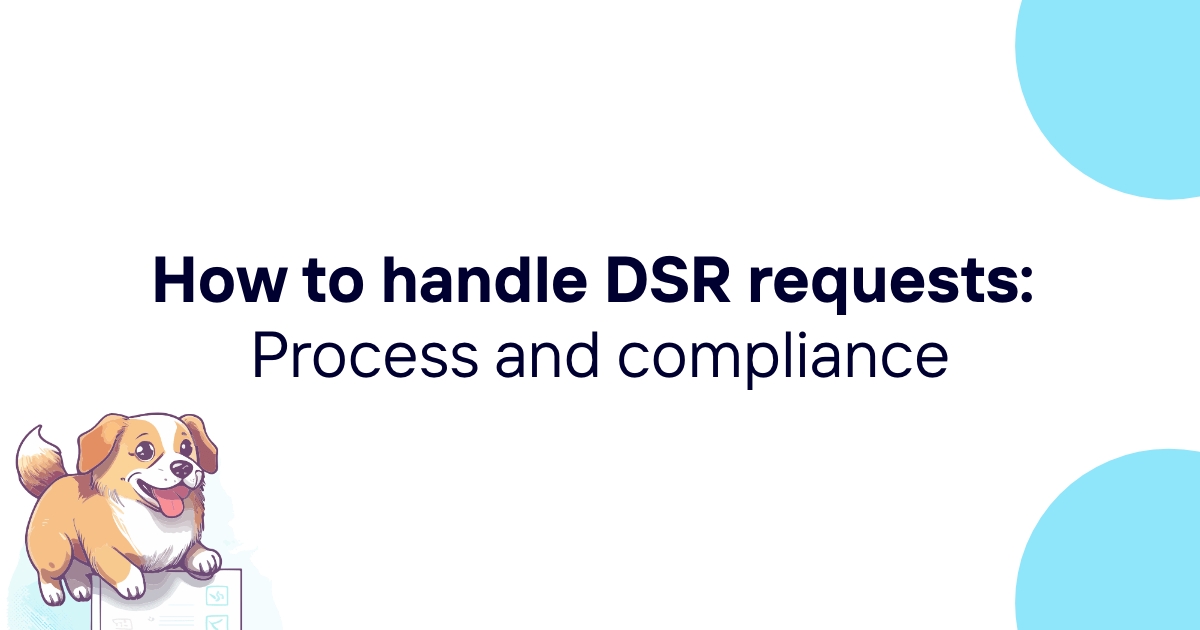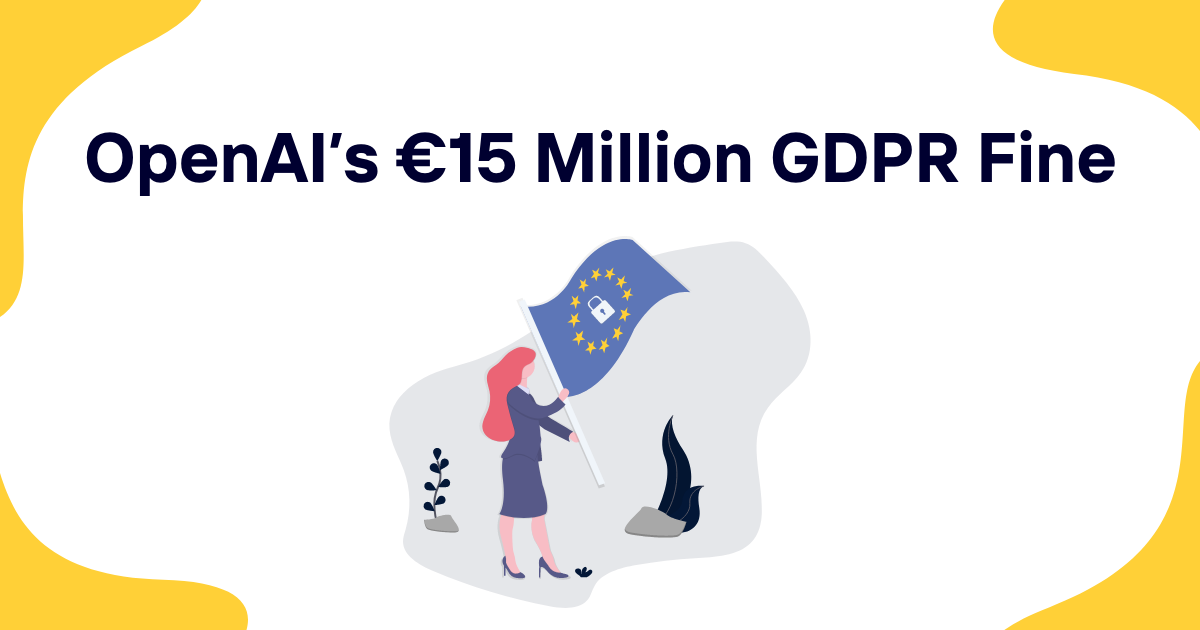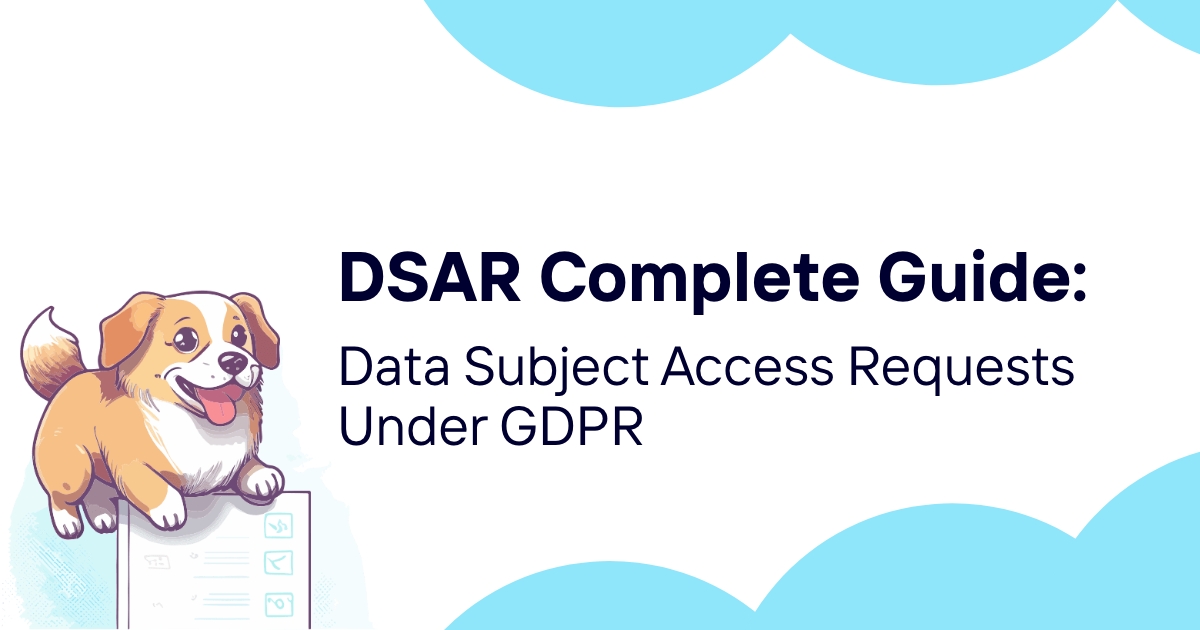Data Subject Requests have transformed from obscure regulatory footnotes into mainstream privacy tools that millions use daily. These requests put individuals back in control of their personal information — something that was unthinkable just a decade ago.
When someone files a DSR request, they're exercising legally protected rights to access, modify, or delete the personal data companies hold about them. But the mechanics behind these requests are more intricate than most people realize, and the obligations they create for businesses are equally complex.
Table of contents
- What is a DSR request?
- The regulatory foundation of DSR requests
- Types of DSR requests explained
- Who can submit DSR requests?
- Business obligations for DSR compliance
- DSR vs DSAR: Clearing up the confusion
- The DSR request process from start to finish
- Common challenges in DSR fulfillment
- Industry-specific DSR considerations
- Technology solutions for DSR management
- Building a DSR compliance program
What is a DSR request?
A Data Subject Request (DSR) represents any formal inquiry submitted by an individual regarding their personal data held by an organization. This broad category includes requests to view data, correct inaccuracies, delete information, restrict processing, or transfer data to another service provider.
DSR requests emerged from privacy regulations that recognized a fundamental imbalance: companies collected vast amounts of personal information while individuals had little visibility or control over that data. The concept flipped this dynamic, giving people meaningful rights to interact with their digital footprints.
The scope of what constitutes "personal data" in DSR requests extends far beyond obvious identifiers like names and email addresses. Location information, browsing patterns, purchase history, biometric data, and even IP addresses can all fall under DSR protections depending on the specific regulation and circumstances.
Organizations that receive DSR requests face legal obligations to respond promptly and comprehensively. The specific requirements vary by jurisdiction, but the underlying principle remains consistent: individuals have enforceable rights regarding their personal data.
The regulatory foundation of DSR requests
The General Data Protection Regulation (GDPR) established the modern framework for DSR requests when it took effect in 2018. This EU regulation created specific rights for data subjects and corresponding obligations for data controllers, setting a global precedent for privacy legislation.
Under GDPR, data subjects can exercise several distinct rights through DSR requests. The "right of access" allows individuals to obtain copies of their personal data along with information about how it's being processed. The "right to rectification" permits correction of inaccurate data, while the "right to erasure" (sometimes called the "right to be forgotten") allows deletion under certain circumstances.
The California Consumer Privacy Act (CCPA) followed GDPR's lead, creating similar rights for California residents. CCPA expanded on some concepts, including the right to opt-out of the sale of personal information and the right to non-discrimination for exercising privacy rights.
Other jurisdictions have developed their own frameworks. Brazil's Lei Geral de Proteção de Dados (LGPD), Canada's proposed Consumer Privacy Protection Act, and various state-level U.S. laws all incorporate DSR-style mechanisms, though with different specific requirements and enforcement mechanisms.
These regulations share common elements but differ in important details. Response timeframes vary from 30 days under GDPR to 45 days under CCPA. The definition of personal data, grounds for refusing requests, and penalty structures all differ between jurisdictions.
Types of DSR requests explained
DSR requests fall into several distinct categories, each with unique processing requirements and business implications. Understanding these categories helps organizations develop appropriate response procedures and resource allocation strategies.
Access requests (DSAR)
Data Subject Access Requests (DSAR) are the most common type of DSR. These requests ask organizations to provide copies of personal data they hold about the requestor, along with details about processing activities, data sharing arrangements, and retention periods.
Access requests often require significant effort to fulfill properly. Organizations must search multiple systems, compile comprehensive reports, and present information in an understandable format. The response must include not just the data itself, but also metadata about its sources, purposes, and legal basis for processing.
Correction requests
When individuals discover inaccurate or incomplete personal data, they can submit correction requests. Organizations must assess these requests carefully, as they're only obligated to correct factually incorrect information, not subjective assessments or legitimately collected accurate data.
Correction requests can be complex when data exists in multiple systems or when corrections affect derived insights or analytics. Organizations need procedures to propagate corrections across all relevant systems while maintaining audit trails of changes made.
Deletion requests
Also known as erasure requests or "right to be forgotten" requests, these ask organizations to delete specific personal data. However, deletion isn't always required or possible. Organizations can refuse deletion requests when they have legitimate grounds to retain the data, such as legal obligations, fraud prevention, or freedom of expression protection.
The technical aspects of deletion can be challenging. True deletion requires removing data from active systems, backups, logs, and any derived datasets. Organizations must balance deletion obligations with data integrity requirements and business continuity needs.
Data portability requests
These requests ask organizations to provide personal data in a structured, machine-readable format that allows transfer to another service provider. Data portability rights typically apply only to data provided directly by the individual or generated through their use of services.
Portability requests require technical capabilities to export data in standardized formats. Organizations must consider what data qualifies for portability, how to structure exports, and how to handle complex data relationships or derived information.
Objection requests
Individuals can object to certain types of data processing, particularly direct marketing or processing based on legitimate interests. When valid objections are received, organizations must stop the specified processing unless they can demonstrate compelling legitimate grounds that override the individual's interests.
Objection requests require careful legal analysis to determine whether the objection is valid and whether any exceptions apply. Organizations need systems to flag objected data and prevent its use for specified purposes while preserving it for permissible uses.
Restriction requests
Sometimes individuals want to limit how their data is used without deleting it entirely. Restriction requests can arise when accuracy is disputed, processing is unlawful but deletion isn't desired, or data is needed for legal claims but no longer required for original purposes.
Restricted data can only be stored and used with explicit consent or for specific limited purposes like legal claims or protecting other individuals' rights. Organizations need technical controls to prevent unauthorized use of restricted data while maintaining its availability for permitted purposes.
Who can submit DSR requests?
The right to submit DSR requests generally belongs to data subjects — the individuals whose personal data is being processed. However, the specific eligibility requirements and scope of these rights vary significantly across different privacy regulations and jurisdictions.
Under GDPR, any individual whose personal data is processed by an organization can submit DSR requests, regardless of their nationality or residence. This creates a broad scope of potential requestors, especially for organizations that operate internationally or collect data from diverse sources.
CCPA limits DSR rights to California residents, but determining residency can be complex for individuals who move frequently, maintain multiple residences, or work across state lines. Organizations must develop reasonable procedures for verifying residency claims while avoiding discriminatory practices.
Third parties can sometimes submit DSR requests on behalf of data subjects. Parents or legal guardians can act for minor children, legal representatives can act for incapacitated adults, and explicitly authorized agents can act with proper documentation. However, organizations must verify these relationships carefully to prevent unauthorized access to personal data.
The age requirements for independent DSR submissions vary by jurisdiction. GDPR allows children to exercise their own rights in some circumstances, while other regulations set specific age thresholds. Organizations processing children's data need age-appropriate procedures and parental involvement protocols.
Employee DSR requests create unique considerations. Current and former employees have generally the same DSR rights as other individuals, but workplace regulations, employment contracts, and legitimate business interests can affect how these rights are exercised and fulfilled.
Business obligations for DSR compliance
Organizations face comprehensive legal obligations when responding to DSR requests. These obligations extend beyond simply providing requested information to encompass procedural requirements, technical safeguards, and ongoing compliance monitoring.
Response timeframes represent one of the most critical obligations. GDPR requires responses within one month, with possible extensions to three months for complex requests. CCPA allows up to 45 days for initial responses, with one additional 45-day extension if needed. Missing these deadlines can result in regulatory investigations and significant penalties.
Identity verification procedures must balance accessibility with security. Organizations need reliable methods to confirm that requestors are who they claim to be while avoiding excessive barriers that could discourage legitimate requests. Verification requirements should be proportionate to the sensitivity of the data and the potential harm from unauthorized disclosure.
The completeness and accuracy of responses is legally mandated. Organizations must conduct thorough searches across all relevant systems and provide comprehensive information about data processing activities. Partial or incomplete responses can violate privacy regulations even if provided within required timeframes.
Documentation requirements create ongoing obligations beyond individual request fulfillment. Organizations must maintain records of DSR requests received, actions taken, timeframes for responses, and any refusals or limitations. This documentation supports regulatory compliance audits and demonstrates good faith efforts at compliance.
Training and resource allocation ensure that staff can handle DSR requests properly. Organizations need designated personnel with appropriate authority and expertise to process requests, make legal determinations, and coordinate technical responses across multiple departments and systems.
DSR vs DSAR: Clearing up the confusion
The relationship between DSR and DSAR creates frequent confusion in privacy discussions. While these terms are often used interchangeably, they have distinct meanings that affect how organizations approach privacy request management.
DSR (Data Subject Request) serves as an umbrella term covering all types of requests individuals can make regarding their personal data. This includes access requests, correction requests, deletion requests, portability requests, and others. DSR represents the broad category of individual rights exercises.
DSAR (Data Subject Access Request) refers specifically to requests for access to personal data and information about processing activities. DSAR represents just one type of DSR, albeit the most common and often the most complex to fulfill properly.
The distinction matters for several practical reasons. Organizations need different procedures, technical capabilities, and resource allocations for different types of DSR. A DSAR might require extensive data compilation and report generation, while a deletion request needs different technical processes and legal analysis.
Regulatory requirements also vary by request type. Access requests have specific content requirements about what information must be provided, while deletion requests involve different legal standards for when refusal is permitted. Organizations need request-specific procedures to ensure compliance across all DSR types.
From a strategic perspective, organizations benefit from understanding the full spectrum of DSR types rather than focusing only on access requests. Comprehensive DSR programs that address all request types demonstrate stronger privacy commitment and reduce regulatory compliance risks.
The DSR request process from start to finish
Effective DSR management requires systematic processes that ensure consistent, compliant, and timely responses. The complexity of these processes scales with organizational size, data volume, and system complexity, but the fundamental steps remain consistent across different contexts.
Request intake and initial assessment
DSR requests can arrive through multiple channels — privacy policy contact forms, dedicated email addresses, customer service inquiries, or third-party platforms. Organizations need centralized intake processes to ensure no requests are overlooked and all receive consistent initial handling.
Initial assessment involves determining the request type, scope, and applicable legal framework. Staff need training to recognize different DSR categories and understand which regulations apply based on the requestor's location and the organization's data processing activities.
Acknowledgment requirements vary by regulation but generally require prompt confirmation that the request has been received. This acknowledgment should reference applicable timeframes and any initial questions about request scope or verification requirements.
Identity verification and validation
Verification procedures must confirm requestor identity without creating excessive barriers to legitimate rights exercises. Organizations typically require some combination of information that matches records, documentation verification, or account-based authentication for existing customers.
The verification process should be proportionate to data sensitivity and potential harm from unauthorized disclosure. Basic account information might require minimal verification, while sensitive financial or health data justifies more robust procedures.
Special verification considerations apply to third-party requests. Organizations must verify both the requestor's identity and their authorization to act on behalf of the data subject. This might involve reviewing guardianship documents, power of attorney forms, or explicit consent statements.
Data discovery and compilation
Comprehensive data discovery requires searching all systems where personal data might be stored. This includes obvious locations like customer databases and less apparent sources like log files, backup systems, email archives, and third-party integrations.
Organizations need data mapping capabilities to understand what personal data they collect, where it's stored, and how it flows between systems. This mapping supports both DSR fulfillment and broader privacy compliance activities.
Compilation processes must organize discovered data into understandable formats while preserving accuracy and completeness. For access requests, this typically involves generating comprehensive reports that explain what data exists and how it's being used.
Legal review and decision making
Each DSR request requires legal analysis to determine appropriate responses. This analysis considers applicable regulations, legitimate grounds for processing, potential exemptions or limitations, and the organization's legal obligations and rights.
Decision-making authority should be clearly assigned to qualified personnel who understand both privacy law requirements and business operations. Complex cases might require consultation with external counsel or privacy specialists.
Documentation of legal decisions supports regulatory compliance and provides defensible records of the organization's reasoning for specific actions or refusals.
Response preparation and delivery
Response formats should be clear, comprehensive, and accessible to typical consumers. Technical jargon should be minimized, and information should be organized logically with appropriate explanations of processing activities and legal basis.
Delivery methods must balance convenience with security. Email delivery is common but may not be appropriate for sensitive data. Secure portals, encrypted communications, or physical delivery might be necessary depending on data sensitivity and regulatory requirements.
Follow-up procedures should address any questions or clarifications requestors might have about responses. Organizations should also monitor whether additional actions are needed, such as corrections or deletions requested after reviewing access request responses.
Common challenges in DSR fulfillment
Organizations encounter numerous obstacles when implementing comprehensive DSR programs. These challenges span technical, legal, operational, and resource dimensions, requiring multi-faceted solutions and ongoing attention from leadership and compliance teams.
Technical complexity and system integration
Modern organizations typically store personal data across dozens or hundreds of different systems. Customer relationship management platforms, email marketing tools, analytics systems, payment processors, and countless other applications all collect and process personal data, often without centralized visibility or control.
Discovering all personal data for a specific individual requires searching across these disparate systems, each with different data structures, query capabilities, and access procedures. Legacy systems often lack modern search capabilities or APIs that would facilitate automated discovery processes.
Data inconsistencies across systems create additional complications. The same individual might be represented differently in various databases, with variations in names, contact information, or identifiers that make comprehensive discovery difficult. Merging and deduplicating information while maintaining accuracy requires careful attention and often manual review.
System integration challenges extend beyond discovery to action fulfillment. Deleting data from one system while preserving it in another for legitimate purposes requires sophisticated technical controls and careful coordination across multiple teams and vendors.
Legal complexity and interpretation challenges
Privacy regulations contain numerous exceptions, limitations, and ambiguities that require careful legal analysis for each DSR request. The "right to be forgotten" under GDPR, for example, includes several exceptions for freedom of expression, legal obligations, and public interest considerations that require case-by-case evaluation.
Cross-jurisdictional complexity arises when organizations operate in multiple regulatory environments with different requirements. A single request might implicate GDPR, CCPA, and other regulations simultaneously, requiring compliance with the most restrictive applicable requirements.
Balancing competing legal obligations creates ongoing challenges. Organizations might have data retention requirements under financial regulations that conflict with deletion requests, or legal discovery obligations that prevent data destruction even when DSR requests are otherwise valid.
Third-party data sharing arrangements add layers of legal complexity. When personal data has been shared with partners, vendors, or service providers, DSR fulfillment might require coordination with these third parties to ensure comprehensive responses.
Resource allocation and operational scaling
DSR volume has grown significantly as awareness of privacy rights increases and regulations expand globally. Organizations that once received occasional privacy inquiries now handle hundreds or thousands of requests annually, straining resources and requiring dedicated personnel and processes.
Cross-functional coordination requirements mean DSR fulfillment involves legal, IT, customer service, and often business line personnel. Coordinating these diverse teams while meeting tight regulatory timeframes requires strong project management and clear escalation procedures.
Quality assurance becomes challenging at scale. Each DSR response requires careful review to ensure completeness and accuracy, but thorough manual review of high-volume requests can overwhelm available resources and create bottlenecks that threaten compliance deadlines.
Training requirements extend beyond dedicated privacy teams to anyone who might encounter DSR requests or handle personal data relevant to DSR fulfillment. Maintaining consistent knowledge and procedures across large organizations requires ongoing investment in training and documentation.
Industry-specific DSR considerations
Different industries face unique DSR challenges based on their data collection practices, regulatory environment, and operational characteristics. Understanding these industry-specific considerations helps organizations develop appropriate DSR programs and set realistic expectations for compliance efforts.
Financial services
Financial institutions collect extensive personal data for identity verification, creditworthiness assessment, fraud prevention, and regulatory reporting. This data often includes sensitive financial information, transaction histories, and credit reports that require special handling for DSR requests.
Regulatory retention requirements in financial services can conflict with DSR deletion rights. Anti-money laundering regulations, tax reporting obligations, and consumer protection laws often require multi-year data retention that limits organizations' ability to fulfill deletion requests.
Third-party data sharing is extensive in financial services, with credit reporting agencies, payment processors, regulatory bodies, and service providers all receiving personal data. DSR fulfillment requires coordination across this complex ecosystem of data sharing relationships.
Know Your Customer (KYC) and identity verification requirements create ongoing challenges for DSR fulfillment. Organizations must maintain certain customer information to comply with regulatory obligations while respecting individual privacy rights and DSR requirements.
Healthcare
Healthcare organizations handle some of the most sensitive personal data, including detailed medical records, treatment histories, and genetic information. HIPAA and other healthcare privacy regulations interact with general privacy laws like GDPR and CCPA in complex ways.
Medical records often contain information about multiple individuals, such as family medical histories or provider notes that reference other patients. Fulfilling DSR requests while protecting third-party privacy requires careful redaction and legal analysis.
Research and public health uses of healthcare data enjoy certain exemptions under privacy regulations, but determining when these exemptions apply requires specialized legal expertise and case-by-case analysis.
Long retention periods are common in healthcare for medical, legal, and research purposes. Some medical records must be retained for decades, limiting the ability to fulfill deletion requests and requiring ongoing privacy protection for retained data.
Technology and social media
Technology companies often collect vast amounts of personal data through user interactions, behavioral tracking, and algorithmic processing. The volume and complexity of this data collection creates significant challenges for DSR fulfillment.
Algorithmic decision-making and machine learning systems incorporate personal data in ways that make extraction or deletion technically complex. When personal data has been used to train machine learning models, "deleting" it might require retraining entire systems.
Real-time data processing systems common in advertising technology and social media platforms must accommodate DSR requirements while maintaining system performance and user experience. Implementing deletion controls in high-speed, distributed systems requires sophisticated technical architecture.
Platform liability for user-generated content creates additional DSR complexities. When users share personal data about others, platforms must balance DSR compliance with freedom of expression protection and practical content moderation limitations.
Retail and e-commerce
Retail organizations collect personal data through online interactions, loyalty programs, payment processing, and physical store visits. The omnichannel nature of modern retail creates data fragmentation across multiple systems and touchpoints.
Third-party integrations are extensive in retail, with payment processors, logistics providers, marketing technology vendors, and analytics platforms all processing customer data. DSR fulfillment requires coordination across this entire ecosystem.
Fraud prevention and security systems in retail often require data retention for investigation and prevention purposes. Balancing these security needs with DSR deletion rights requires careful policy development and legal analysis.
Personalization and recommendation systems rely on extensive data collection and analysis to provide customized shopping experiences. DSR fulfillment must consider how data deletion affects these systems while respecting individual privacy rights.
Technology solutions for DSR management
The complexity and volume of DSR requests have driven development of specialized technology solutions designed to automate and streamline privacy request management. These tools range from simple request tracking systems to comprehensive privacy management platforms with advanced data discovery and fulfillment capabilities.
Automated request management systems
Modern DSR management platforms provide centralized intake systems that can accept requests through multiple channels and automatically route them to appropriate personnel based on request type, jurisdiction, and organizational structure. These systems maintain audit trails of all actions taken and provide real-time status tracking for both internal teams and requestors.
Workflow automation capabilities help organizations manage the complex, multi-step process of DSR fulfillment while ensuring compliance with regulatory timeframes. Automated reminders, escalation procedures, and approval workflows prevent requests from falling through organizational cracks and provide visibility into potential compliance issues.
Template-based response systems allow organizations to generate consistent, comprehensive responses while reducing the manual effort required for each request. These templates can be customized based on request type, data categories involved, and applicable regulations while maintaining consistency and completeness.
Integration capabilities allow DSR management systems to connect with existing business applications, enabling automated data discovery and action execution across multiple systems. API-based integrations can significantly reduce the manual effort required for comprehensive DSR fulfillment.
Data discovery and mapping tools
Comprehensive data discovery requires sophisticated tools that can identify personal data across diverse systems and data stores. Modern privacy technology platforms use various techniques including database scanning, file analysis, and machine learning-based data classification to locate personal data automatically.
Data mapping capabilities provide visual representations of personal data flows within organizations, showing how data moves between systems, what processing activities occur, and who has access to different data categories. These maps support both DSR fulfillment and broader privacy compliance activities.
Data lineage tracking helps organizations understand the complete lifecycle of personal data, including its origins, transformations, and current locations. This capability is particularly important for complex DSR requests that require comprehensive data discovery across multiple systems and time periods.
Real-time data discovery allows organizations to maintain current understanding of their data landscape as systems and processes change. Traditional data mapping exercises quickly become outdated, but continuous discovery systems provide ongoing visibility into personal data processing activities.
Identity resolution and verification systems
Robust identity verification systems help organizations confirm requestor identities while minimizing barriers to legitimate rights exercises. These systems can integrate with existing customer authentication mechanisms and provide risk-based verification procedures based on data sensitivity and potential harm from unauthorized disclosure.
Identity resolution capabilities help organizations link DSR requests to all relevant data records, even when personal data is stored inconsistently across multiple systems. Advanced matching algorithms can identify related records despite variations in names, contact information, or other identifiers.
Fraud detection systems protect against malicious DSR requests designed to gain unauthorized access to personal data. These systems can identify suspicious request patterns, verify requestor authenticity, and flag potentially fraudulent requests for additional review.
Privacy-preserving verification methods allow organizations to confirm identities without collecting additional personal data or creating new privacy risks. These approaches balance verification requirements with data minimization principles and privacy by design concepts.
Analytics and compliance monitoring
Comprehensive analytics capabilities help organizations understand DSR request patterns, identify potential compliance issues, and optimize their privacy programs. Request volume trends, response time analysis, and fulfillment success rates provide insights into program effectiveness and resource requirements.
Regulatory compliance monitoring systems track organizations' performance against applicable privacy regulations and identify potential compliance gaps before they become violations. These systems can monitor response timeframes, completeness requirements, and other regulatory obligations automatically.
Risk assessment tools help organizations prioritize DSR requests and allocate resources appropriately based on regulatory requirements, data sensitivity, and potential compliance risks. These tools can also identify systemic issues that might require broader privacy program improvements.
Reporting capabilities provide visibility into DSR program performance for internal stakeholders and regulatory authorities. Comprehensive reports can demonstrate compliance efforts, identify improvement opportunities, and support regulatory examinations or audits.
Building a DSR compliance program
Successful DSR compliance requires comprehensive programs that address policy, process, technology, and organizational change management dimensions. These programs must be tailored to specific organizational contexts while meeting regulatory requirements and supporting business objectives.
Governance and organizational structure
Effective DSR programs require clear governance structures with defined roles, responsibilities, and decision-making authority. Privacy teams typically lead DSR programs, but successful implementation requires engagement from legal, IT, customer service, and business line personnel.
Executive sponsorship provides the authority and resources necessary for comprehensive DSR compliance. Privacy regulations carry significant penalties for non-compliance, and executive leadership support helps ensure that DSR programs receive appropriate priority and investment.
Cross-functional coordination mechanisms prevent DSR requests from falling between organizational silos. Clear escalation procedures, regular communication channels, and shared performance metrics help maintain alignment across diverse teams involved in DSR fulfillment.
Training programs ensure that all personnel understand their roles in DSR compliance and can execute their responsibilities effectively. Training should cover legal requirements, procedural steps, technology tools, and escalation procedures for complex or unusual requests.
Policy and procedure development
Comprehensive DSR policies provide the foundation for consistent, compliant request handling. These policies should address all applicable regulations, request types, and organizational contexts while providing clear guidance for staff responsible for DSR fulfillment.
Standard operating procedures translate high-level policies into specific, actionable steps for different types of DSR requests. These procedures should include verification requirements, discovery processes, legal review standards, and response preparation guidelines.
Exception handling procedures address complex or unusual requests that don't fit standard processes. These procedures should provide clear escalation paths, specialized expertise requirements, and decision-making criteria for non-routine situations.
Documentation standards ensure that all DSR activities are properly recorded for regulatory compliance and internal management purposes. Documentation should be sufficient to demonstrate compliance efforts while protecting confidential information and attorney-client privileged communications.
Performance monitoring and continuous improvement
Key performance indicators (KPIs) help organizations track DSR program effectiveness and identify improvement opportunities. Common metrics include response timeframes, request completion rates, data discovery accuracy, and customer satisfaction with DSR responses.
Regular program assessments evaluate DSR compliance against regulatory requirements and organizational objectives. These assessments should consider legal compliance, operational efficiency, technology effectiveness, and resource adequacy.
Regulatory monitoring ensures that DSR programs remain current with evolving privacy laws and enforcement guidance. Privacy regulations continue to develop rapidly, and DSR programs must adapt to new requirements and regulatory interpretations.
Stakeholder feedback mechanisms provide insights into DSR program effectiveness from both internal teams and external requestors. This feedback supports continuous improvement efforts and helps identify potential compliance gaps or operational inefficiencies.
The landscape of DSR compliance continues developing rapidly as privacy regulations expand globally and enforcement activities increase. Organizations must prepare for evolving requirements while building sustainable, scalable DSR programs that can adapt to changing circumstances.
Modern compliance software platforms have revolutionized how organizations approach DSR management by providing integrated solutions that address the full spectrum of privacy request requirements. These platforms combine automated data discovery, identity verification, workflow management, and regulatory compliance monitoring in unified systems that dramatically reduce the complexity and resource requirements of DSR compliance.
ComplyDog represents the next generation of privacy compliance technology, offering comprehensive DSR management capabilities alongside broader GDPR compliance tools. The platform's automated data mapping identifies personal data across organizational systems, while intelligent workflow management ensures timely, compliant responses to all DSR request types.
Organizations using compliance software like ComplyDog can transform DSR compliance from a reactive, resource-intensive process into a streamlined, proactive capability that supports both regulatory compliance and business objectives. The platform's integrated approach reduces the technical complexity of DSR fulfillment while providing the documentation and audit capabilities necessary for regulatory compliance.
The investment in comprehensive privacy compliance technology pays dividends through reduced regulatory risk, improved operational efficiency, and enhanced customer trust. As privacy regulations continue expanding globally and enforcement activities intensify, organizations with robust DSR compliance capabilities will maintain competitive advantages while avoiding the significant costs and reputational damage associated with privacy violations.
For organizations ready to modernize their privacy compliance approach and build sustainable DSR management capabilities, exploring platforms like ComplyDog at ComplyDog.com provides a starting point for transforming privacy compliance from a burden into a strategic advantage.


















